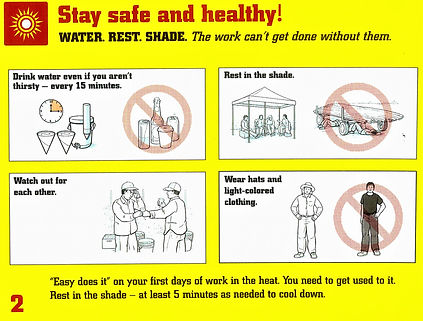labor
employment

Our diverse agricultural production relies upon skilled people in year-round and seasonal jobs. Farmers and ranchers face very real challenges in ensuring they can hire from among a reliable, stable and legal workforce.
CFBF encourages worker health and safety training programs to prevent farm worker injury and illness.
Legislation addresses piece-rate compensation
immigration

Farm Bureau seeks to improve labor policies affecting agriculture and to provide farmers and ranchers with information on existing laws and regulations, including a comprehensive immigration policy.
Farm Bureau supports a bipartisan compromise that creates a visa program for the entry of a foreign legal workforce to work in agriculture, and that allows those currently experienced yet unauthorized agricultural workers who pay a fine and pass a background check to continue working in agriculture.
New American Workforce is now offering a secure and confidential online citizen services portal with privacy safeguards in place. The portal offers remote legal review and assistance, offered by trusted non-profit legal providers. Visit the website citizenworks.org for more information.
ag employees

Minimum wage, "day of rest" and "seventh-day" overtime requirements for agricultural employees in California changed on January 1, 2017. Changes occur incrementally through 2025.
Changes on January 1, 2022
Minimum Wage
-
$14/hour for "small" employers (25 or fewer employees at all times during a pay period)
-
$15/hour for "large" employers (26 or more employees at all times during a pay period)
Ag Overtime
-
Overtime (1.5x regular rate of pay) for more than 8 hours per workday, 40 hours per workweek for "large" employers
-
Double time (2x the employee's regular rate of pay) for more than 12 hours per workday for "large" employers
-
Overtime for more than 9.5 hours per workday, 55 hours per workweek for "small" employers
Changes on January 1, 2023
Minimum Wage
-
$15/hour for all employers
Ag Overtime
-
Overtime (1.5x regular rate of pay) for more than 9 hours per workday, 50 hours per workweek for "small" employers
Changes on January 1, 2024
Ag Overtime
-
Overtime (1.5x regular rate of pay) for more than 8.5 hours per workday, 45 hours per workweek for "small" employers
Changes on January 1, 2025
Ag Overtime
-
Overtime (1.5x regular rate of pay) for more than 8 hours per workday, 40 hours per workweek for "small" employers
-
Double time for more than 12 hours per workday for "small" employers
Heat Illness Prevention

California employers are required to take these four steps to prevent heat illness:
-
Training:
Train all employees and supervisors about heat illness prevention.
-
Water:
Provide enough fresh water so that each employee can drink at least 1 quart per hour, or four 8 ounce glasses, of water per hour, and encourage them to do so.
-
Shade:
Provide access to shade and encourage employees to take a cool-down rest in the shade for at least 5 minutes. They should not wait until they feel sick to cool down.
-
Planning:
Develop and implement written procedures for complying with the Cal/OSHA Heat Illness Prevention Standard.

-To read about prevention guidelines and access training materials, check out these materials in multiple languages (99calor.org). These materials can be ordered free of charge by emailing heat@dir.ca.gov.
-For essential tips and practices to keep the workplace safe during hot days, watch the 2023 HIP Network Call (www.videbookcase.org).
-Check out the latest news and announcements from Cal/OSHA (www.dir.ca.gov).
Wildfire Worker Safety

Wildfire smoke and cleanup presents hazards that employers and workers in affected regions must understand. Smoke from wildfires contains chemicals, gases and fine particles that can harm health. Hazards continue even after fires have been extinguished and cleanup work begins. Proper protective equipment and training is required for worker safety in wildfire regions.
Power outages can also present electrical and other hazards for workers. Proper installation and use of generators can prevent electrocution hazards. Workers must also be aware of the potential of electrocution or being injured by moving parts of machinery and other equipment when power is restored. Workers can also face health hazards from power outages in unventilated areas when ventilation systems are not working.
Cal/OSHA has a regulation (section 5141.1) to protect employees exposed to wildfire smoke. The regulation requires the following:
-
Identification of harmful exposures
-
Communication
-
Training and instruction
-
Control of harmful exposures
-
Specific particulate sampling requirements if an employer opts to monitor employee exposure with a direct reading instrument
Workplace Safety

Employee safety resources at your workplace can help prevent employee injuries.
View resources at State Fund:



